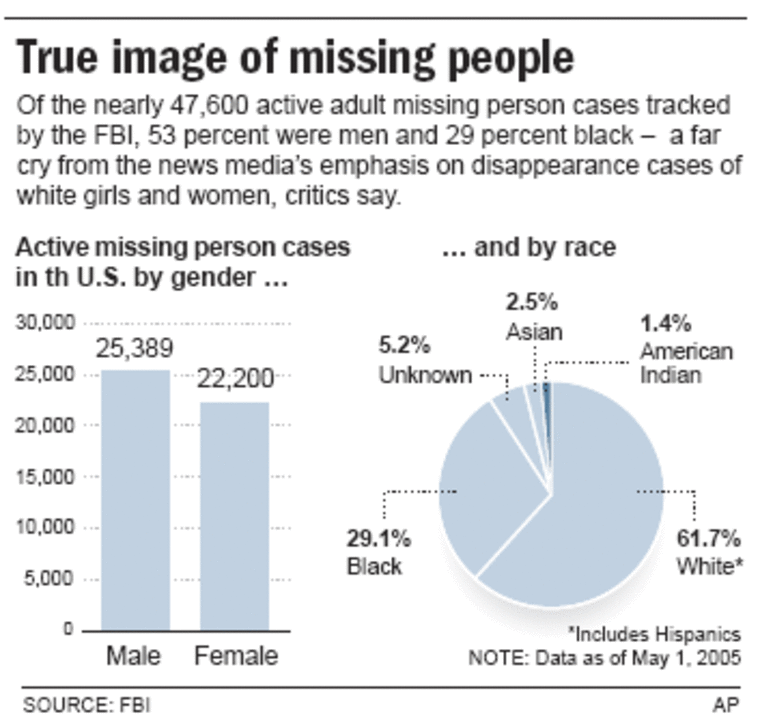Most of the missing adults tracked by the FBI are men. More than one-in-five of those abducted or kidnapped are black.
But you might not get that impression from the news media, and some journalism watchdogs are now taking the industry to task for what they see as a disproportionate emphasis on cases in which white girls and women — overwhelmingly upper-middle class and attractive — disappear.
Television executives, who receive much of the criticism, defend their coverage. They stress that cases such as the recent disappearance in Aruba of 18-year-old Natalee Holloway of Alabama are extraordinary, and would be newsworthy no matter her background.
Attention to few
Indeed, no critic denies that the Holloway case and other disappearances are wrenching for those involved. But some insist that media attention on so few people overshadows the more than 100,000 active files on missing adults and children currently tracked by the Federal Bureau of Investigation.
“To be blunt, blond white chicks who go missing get covered and poor, black, Hispanic or other people of color who go missing do not get covered,” said Tom Rosenstiel, director of the Washington-based Project for Excellence in Journalism. “You’re more likely to get coverage if you’re attractive than if you’re not.”
“In terms of giving citizens the information they need, I think we’re failing because we’re not giving an accurate portrayal of the world around them,” said Dori Maynard, president of the Robert C. Maynard Institute for Journalism Education, a group that works to improve diversity in newsrooms and news coverage.

On its Web site, the National Center for Missing Adults profiles more than 1,000 individuals, including photos, physical descriptions and short narratives of when they were last seen. They are young and old, working-class and professional, of all ethnic backgrounds. Most are average-looking.
And most never receive a mention in their local newspapers or television broadcasts, said Erin Bruno, a case manager at the center who tries to interest media outlets in publicizing missing adults.
“We want everyone to get coverage, but we don’t get to make those choices,” said Bruno, who estimates that one out of the five news releases she sends out each week gets media attention.
Of the nearly 47,600 active adult cases tracked by the FBI as of the beginning of May, 53 percent were men and 29 percent black. (About 12 percent of the U.S. population is black, Census data show.) About 62 percent of those missing are white, but that figure includes Hispanics.
‘Unconscious bias’
“Quoting those (FBI) statistics — it’s like saying ‘99 percent of the nations in the world are not at war, so why are you focusing on the war?’ But Iraq is an extraordinary event involving Americans,” said Mark Effron, vice president of news at MSNBC TV. “What makes news is the unexpected.”
He said Holloway’s disappearance during a chaperoned trip is unusual, and would have been heavily covered by MSNBC regardless of her gender or ethnicity.
Christa Robinson, a spokeswoman for CNN, said that a wide range of editorial considerations — including competition from other news events — impact the attention given to each potential story. The race or ethnicity of a possible victim, she said, is not a factor.
But Rosenstiel said that analyses of cable news in recent years shows an upward “trajectory of the salacious crime story” including those of missing white females such as Chandra Levy, Laci Peterson, JonBenet Ramsey and Elizabeth Smart.
Many consider women more sympathetic potential victims than men — and white women even more so, said Kristal Brent Zook, a professor at the Columbia University School of Journalism. Zook wrote an article published in this month’s Essence magazine about missing black women who are largely ignored.
‘The virginal ... princess is missing’
“Who’s appealing? Who’s sexy?” she asked. “The virginal, pure, blond princess is missing. ... It has a lot to do with class and sexuality and ageism, not just race.”
Maynard said many news directors, editors and everyday people stereotype men and minorities who turn up missing and assume “it’s drugs or criminal activity or some sort of pathology.” If journalists — consciously or unconsciously — expect men and minorities to be crime victims, she said, few will consider it newsworthy if that actually happens.
“I don’t think it’s a conscious thing,” she added. “I think it’s an unconscious bias.”
Dan Shelley, chairman of the Radio-Television News Directors Association (RTNDA), agreed that unconscious bias is possible.
But “to the extent that we as an industry have created a perception in some that we’re ignoring missing-person cases involving men or people of certain ethnicities, it’s unfortunate,” he said. “The more diverse our work forces are and newsrooms are, the greater the chances our stories will truly reflect our communities.”
In 2004, 22 percent of the broadcast news work force were people of color, up from 17 percent in 1995, RTNDA data show. About 30 percent of Americans are minorities, Census data show.